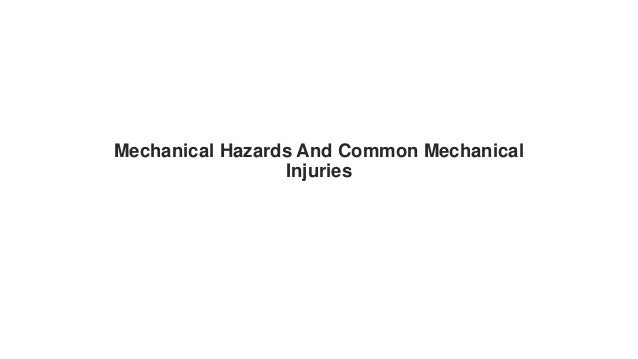
Mechanical Hazards And Common Mechanical Injuries.pdf
- 1. Mechanical Hazards And Common Mechanical Injuries
- 2. Mechanical hazards are hazards created by the use of or exposure to either powered or manually operated equipment, machinery and plant. Mechanical injuries are mostly caused either by contact or entanglement with machinery. Part of the machinery that could be hazardous to workers include sharp edges, hot surfaces, moving parts, flywheel, pulley, belt, etc.
- 3. Where Mechanical Hazards Occur It occurs majorly in three (3) area: The point of operation: Point where work is performed on the material, such as cutting, shaping, boring, etc. Power transmission apparatus: Components of the mechanical system that transmit energy to the part of the machine performing the work. Example, flywheels, pulleys, belts, connecting rods, couplings, cams, spindles, chains, cranks, gears, etc. Machine moving parts: Parts of the machine that move while the machine is working. These may include reciprocating, rotating, and transverse moving parts, as well as feed mechanisms and auxiliary parts of the machine.
- 4. Common Mechanical Injuries Fracture: Fracture is the medical term for a broken bone. It can be classified as simple, compound or complete fracture. Puncturing/Stabbing: Puncturing results when an object penetrates straight into the body and pulls straight out, creating a wound in the shape of the penetrating object. Straining and spraining: A strain results when muscles are overstretched or torn. Strains and sprains can cause swelling and intense pain. Impact: Being hit by ejected parts of the machinery or equipment Friction and abrasion: A section of the skin being rub away by the machine.
- 5. • Entrapment: Being caught in a moving part of a machine or equipment or plant. • Crushing: Collision of plant with a person can result to crushing. • Shear: Can be two moving parts (sharp or otherwise) moving across one another. • High pressure injection: This is an injury caused by high-pressure injection of oil, grease, diesel fuel, gasoline, solvents, water, or even air, into the body. • Cut: Severing of a human body part by a cutting motion e.g. amputation Continue Reading